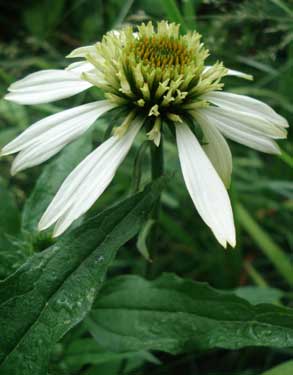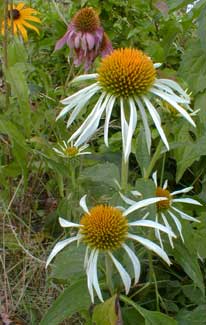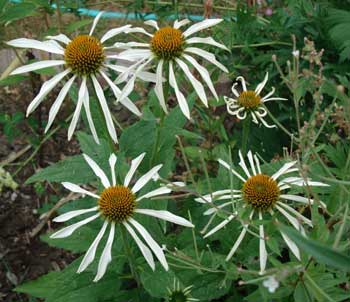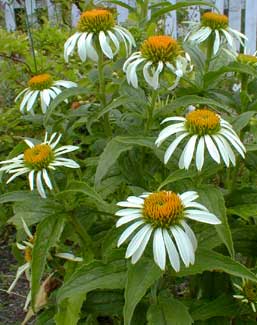
White Swan Echinacea
"O father, father, draw your dam,
There's either a mermaid or a milk-white swan."
-traditional English ballad
 For me personally, coneflowers required some getting used to in the beginning, because they looked rather like wilted daisies.
For me personally, coneflowers required some getting used to in the beginning, because they looked rather like wilted daisies.After I got used to the fact the petals are severely reflexed, the initial impression they're wilting is not so strong, & the persistance of their big showy flowers makes them so very dramatic.
In the long run they even became my favored perennials & I now find it difficult to restrain myself from adding more & more of them to the gardens.
Echinacea purpurea var alba 'White Swan' is a nice change of pace from the majority of cultivars for this species, which are purple rather than white.
The fat round red cones in the middle of long, slim, pure white petals attract butterflies & other pollinators. It is for these spiked cones that the species is sometimes called Hedgehog Coneflower, & the genus name means "hedgehog."
 As early as June flowers are developing (the first photo is of a June blossom with its cone not yet ripened). It is in fullest flower by July, lasting easily through August, usually to the end of September, & sometimes (with timely deadheading of spent blooms) well into October, or whenever morning frosts finally slow it down.
As early as June flowers are developing (the first photo is of a June blossom with its cone not yet ripened). It is in fullest flower by July, lasting easily through August, usually to the end of September, & sometimes (with timely deadheading of spent blooms) well into October, or whenever morning frosts finally slow it down.Although it blooms summer & early autumn most vigorously, it may continue to bloom right into winter if there are only a few mildly frosty nights. Like regular echinacea it requires a lot of sun, & getting it, tries to avoid the seasons.
If you know there's major cold weather immediately around the corner, & the 'Whist Swan' is nevertheless trying to bloom one last time, clip off the flower stems so that it won't exhaust itself before belatedly resting for the winter.
 Though drought hardy, it does better in cool drought than in extremely hot droughts, & oughtn't have its tolerances tested here in Zone 8.
Though drought hardy, it does better in cool drought than in extremely hot droughts, & oughtn't have its tolerances tested here in Zone 8.Moderate though our summer weather is, we're nevertheless at the high end of 'White Swan's' zone preferences (USDA zones 4 through 8; with more attention & protection, it is stretchable from 3 to 9).
Perfect drainage is always required, but in long summery periods without any rain at all, it really must be moderately watered to flower strongly.
When the flower petals fade, the cones remain as decorative seedheads, sometimes attracting seed-eating birds. The cones range from yellow-green to olive or bright orange, black by the time they are worn out & the petals have shriveled away. It self-sews easily.
It is particularly hardy, though of semi-dwarf stature compared to regular purple echinaceas. It can top out at two feet, thirty inches would be really tall for 'White Swan.' After a few years it will have spread to a two-foot wide clump, & may require division, but in a harsh xeriscape location insufficiently watered at high summer it may merely hold its own without spreading.
Formerly Echinaceas were included in the Rudbeckia genus, & we've a 'Goldsturm' Rudbeckia growing next to 'White Swan' that indeed looks closely related. The second photo snapped in August captures one of the 'Goldsturm' blooms & also a bloom from a dwarf purple echinacea, 'Kim's Knee-high.'
Continue to:
'Fragrant Angel' Echinacea